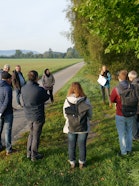Learn more about the project
Project Update
Publish date: January 27, 2024

Preventing biodiversity loss in waterbodies despite climate change
Preventing biodiversity loss in waterbodies despite climate changeLearn more about the project
Project Update
Preventing biodiversity loss in waterbodies despite climate change
Preventing biodiversity loss in waterbodies despite climate changePublish date: January 27, 2024
The project focuses on fife key priorities:
1. Assessing and documenting fish diversity, mapping species distribution, and describing new species
The ability to halt biodiversity loss and effectively protect habitats fundamentally depends on correctly identifying species and comprehensively describing biological diversity. Taxonomy plays a crucial role in this effort, as it focuses on the recognition, classification, and understanding of biodiversity. Until now, approximately one-fifth of the more than 120 fish species known to occur in Switzerland are still awaiting formal description. Understanding fish diversity, defining their geographical boundaries and habitat requirements, and assessing current threats are essential for their protection. As part of the LANAT-3 project, target fish groups such as stone loaches (Barbatula spp.), minnows (Phoxinus spp.), sculpins (Cottus spp.), gudgeons (Gobio spp.) and others are being studied, their identification resolved, and new species described (Calegari et al. accepted). Accurate identification and classification of these species are key to legal protection and enable appropriate conservation planning and efforts (Josi et al. 2024a).
2. Identifying environmental constraints that drive species distribution
Both natural factors, like climate and food availability, and human activities affect the distribution of species. Here, ecological niche models are used to predict where species are likely to be found, but these models don’t explain why certain areas are suitable or not (Josi et al. 2024b). Therefore, a new approach has been developed in this project using Explainable AI to help identify which environmental factors make a habitat good or bad for a species at a given location. This makes it possible to quantify the extent of human activity on a species’ natural habitat and identify the key factors driving loss of species in a given area (Waldock et al. 2024). These insights help designing targeted conservation measures to protect aquatic biodiversity (Wegscheider et al. 2024).
3. Identifying priority areas for conservation or restoration, considering climate change
Building on the above insights, a systematic conservation planning approach is being developed to identify priority areas for protection, future climate refugia, and regions requiring urgent restoration. Based on this evidence-based planning and prioritization, the Saane-Sense catchment has been identified as one of many key regions in Switzerland with high conservation needs. Within this pilot region the project aims to bridge science and practice to develop evidence-based effective and efficient recommendations.
4. Analysing stakeholders’ practices and perspectives
There are diverse laws and regulations, related enforcement areas and stakeholders directly or indirectly linked to aquatic biodiversity and climate change in Switzerland. To be able to provide targeted and meaningful contributions to the conservation and restoration of aquatic biodiversity, it is important to know what is already going on, what are the perspectives of stakeholders, how they interact and where there might be deficits and opportunities. To this end, the project conducts a context analysis and a social-ecological network analysis in the test region Lower Emme (Zinn et al. 2024) and in the pilot region Saane-Sense.
5. Co-developing and incubating evidence-based, practicable strategies
Although Switzerland has legal and strategic frameworks for aquatic biodiversity conservation, their implementation faces numerous challenges, including limited resources, opportunistic rather than evidence-based approaches, conflicting objectives, and limited collaboration among key stakeholders. To overcome these issues, close cooperation between science and practice is essential, along with the implementation of adaptive and integrated management. Participatory processes bring together relevant stakeholders to jointly identify evidence-based, practicable strategies and measures for the effective and efficient conservation and restoration of aquatic biodiversity in Switzerland. Initial insights were gained in the test region (Aeschlimann et al. 2024a; Aeschlimann et al. 2024b) and are further elaborated in the pilot region, where conservation and restoration needs are particularly high, to ultimately generate learning for entire Switzerland.
Media releases:
Team
- Project contactProject contact
Cyrill Hess
Research Scientist
